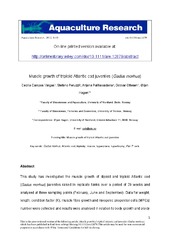Muscle growth of triploid Atlantic cod juveniles (Gadus morhua)
Permanent link
https://hdl.handle.net/10037/8960Date
2015Type
Journal articleTidsskriftartikkel
Peer reviewed
Author
Vargas, Cecilia Campos; Peruzzi, Stefano; Palihawadana, Anjana; Ottesen, Oddvar; Hagen, ØrjanAbstract
This study has investigated the muscle growth of
diploid and triploid Atlantic cod (Gadus morhua)
juveniles raised in replicate tanks over a period
of 29 weeks and analysed at three sampling
points (February, June and September). Data for
weight, length, condition factor (K), muscle fibre
growth and myogenic progenitor cells (MPCs)
number were collected and results were analysed
in relation to body growth and ploidy status.
Diploids were significantly heavier than triploids
throughout the trial (~10–20%) and had K in
June and September samplings. Over the whole
period, the rate of muscle fibres’ recruitment was
318 fibres per day and 252 fibres per day for
diploid and triploid cod respectively. The larger
body weight of diploids resulted in a total num-
ber of fast fibre number of 114 979 compared
to 91 086 in triploids. The average diameter of
the 2.5% of the smallest fibres (2.5th percentile)
was higher in diploids than triploids at the start
of the trial, with a reversed picture for the aver-
age of the upper 2.5% (97.5th percentile) at the
end of the trial. The probability density function
of the estimated muscle fibre diameters showed
similar fibre size distribution between size-
matched diploids and triploids at all sample
points. The peak fibre diameter was approxi-
mately 25 lm in February and increased to
approximately 50 lm in June and September,
irrespectively of ploidy. Pax 7 were used as
molecular markers for MPCs. A positive correla-
tion between Pax 7+ cells and total body length
was observed only among triploid fish at the
onset of the experiment.
Description
Accepted manuscript version. Published version at http://doi.org/10.1111/are.12879.


 English
English norsk
norsk